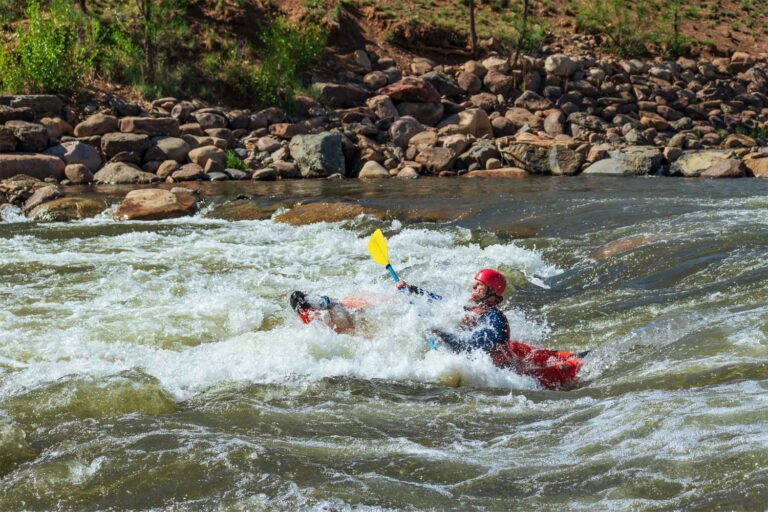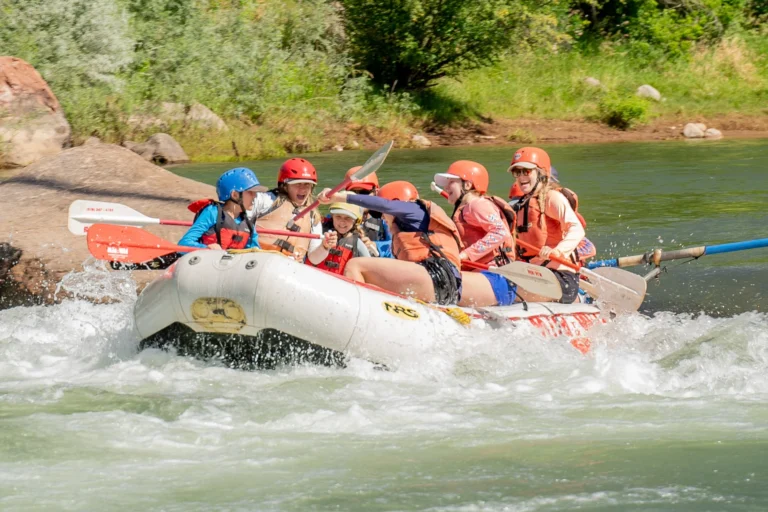
Well good paddlers, the time has come once again. Summer has turned up with its wonderful and inevitable simmer, and with it tamer waters. It warrants the profoundly deep question that confronts us all, fiberglass fin in hand— Shall I kayak, or shall I raft?
Somewhere at some point, someone started a nasty rumor that inflatable kayaking is reserved only for the most elite of ducky olympians. Luckily, that’s not a thing, no matter how entertaining a ducky race at the Olympic level would be. But there are some things to consider when choosing between your own destiny in a ducky, or joining the party in the raft.
Some housekeeping items that may make the decision quicker are how old the paddler is. Kayakers must be 12+ for Durango river trips, and 8+ for doubles and 12+ for singles for Moab river trips. Also if you don’t know how to swim, this discussion will conclude now as you’ll be rafting! Woohoo!!
Now, if you weren’t stopped by the sentiments above— Here are 3 questions to ask yourself before embarking on the great voyage of your river trip:
#1. How Big Do You Want Your Splashes?
Not to get too deep into the physics here, but the smaller the craft, the bigger the splash. So if you opt for an inflatable kayak, be prepared to be bespattered on the regular as every respectable ripple and wave is going to rock the boat. Your kayak guide will give you all the instruction you need to break through the swell, you’ll just be in charge of the follow through!
Class II rapids that usually splash the front of a raft can soak kayakers head to toe. As for Class III rapids, which often soak everyone in a raft, they’ll supply a memorable, boat-engulfing ride in a kayak
These crafts also sit nearly even with the water table, while rafts sit about 2 feet above the surface. This means inflatable kayakers are sitting in a little bit of water in their boat the entire time. Not to worry though— this is an ironic method of how the craft self-bails.
Meanwhile, rafters will stay mostly dry when they’re not bounding through the whitewater sections of their trip. Rafts are also self-bailing, so only your feet stay wet throughout the journey.
So if getting wet for the whole river run sounds refreshing to you, consider a kayak. If not, definitely jump in the raft!
#2. How Adventurous Do You Want to Be?
Another thing to consider when choosing a kayak or raft is how much freedom you fancy.
Rafting during the low water season means the experience will lean on the mild side while your guide takes care of navigating you downstream. You’ll have plenty of time to relax, with a few friendly splashes sprinkled in along the way.
And we know we said we wouldn’t gab on about the crazy science of all this stuff, but rafts are also bigger and heavier, so they move at a slower pace than kayaks. This also means they have to strategically navigate between the rocks that emerge from the riverbed. Kayaks on the other hand can glide more easily between obstacles like the little ducks they are.
To that point, kayakers are in charge of getting themselves downstream as their guide quacks out instruction. This means when it’s time to tackle a rapid, skirt around a rock, or pick a line through whatever is up ahead, it’s all up to the paddler! This adds more zest to the experience, on top of the zest of getting through the rapids.
So if you want a guide to be in control, raft it up! If not, the kayak is probably calling to you.
#3. How Active Do You Want To Be?
Rafting can be as active or inactive as you like. Guests don’t typically paddle the entirety of their trip like their guide, which is great for those who want some time to relax on the water.
Alternatively, kayaking is an active experience all around! Kayakers have to paddle most of the time to move and steer themselves downstream. Another important detail to add here— you’ll probably get rinsed out of your kayak at least once on the trip.
This in turn involves some swimming and physicality to get back into your craft (which your guide will instruct on). So as a reminder, you do need to know how to swim if you choose to kayak! It’s all part of the fun, especially if you appreciate the exercise. Again, this isn’t to say you have to be an olympian, by golly not even an athlete to kayak, but you do have to be ready to put some work in.
If you’re down to paddle and take some swims during your river trip, definitely consider a kayak!
In Sum, To Kayak or To Raft?
If you’re looking for a splashy hands-on experience when water levels start to drop, but you’re still uncertain if you’re ready to kayak, opt for a shorter trip that gives you between 1-2 hours on the water. This will allow you to get the excitement (and refreshment) you’re looking for, without getting too tired.
Rafting during the low water season can still be a hands-on experience, especially as you help your guide maneuver through the rocky sections of the river. Just be prepared for a mild experience in a raft, while kayaking will be more intermediate.
Kayaking and rafting trips travel together, so if you’re with people who may want one option versus another, you can do both!
All in all, however you end up floating the river, it’s going to be better than not floating the river. Now let’s bask in sizzle together and have some fun in the sun!





